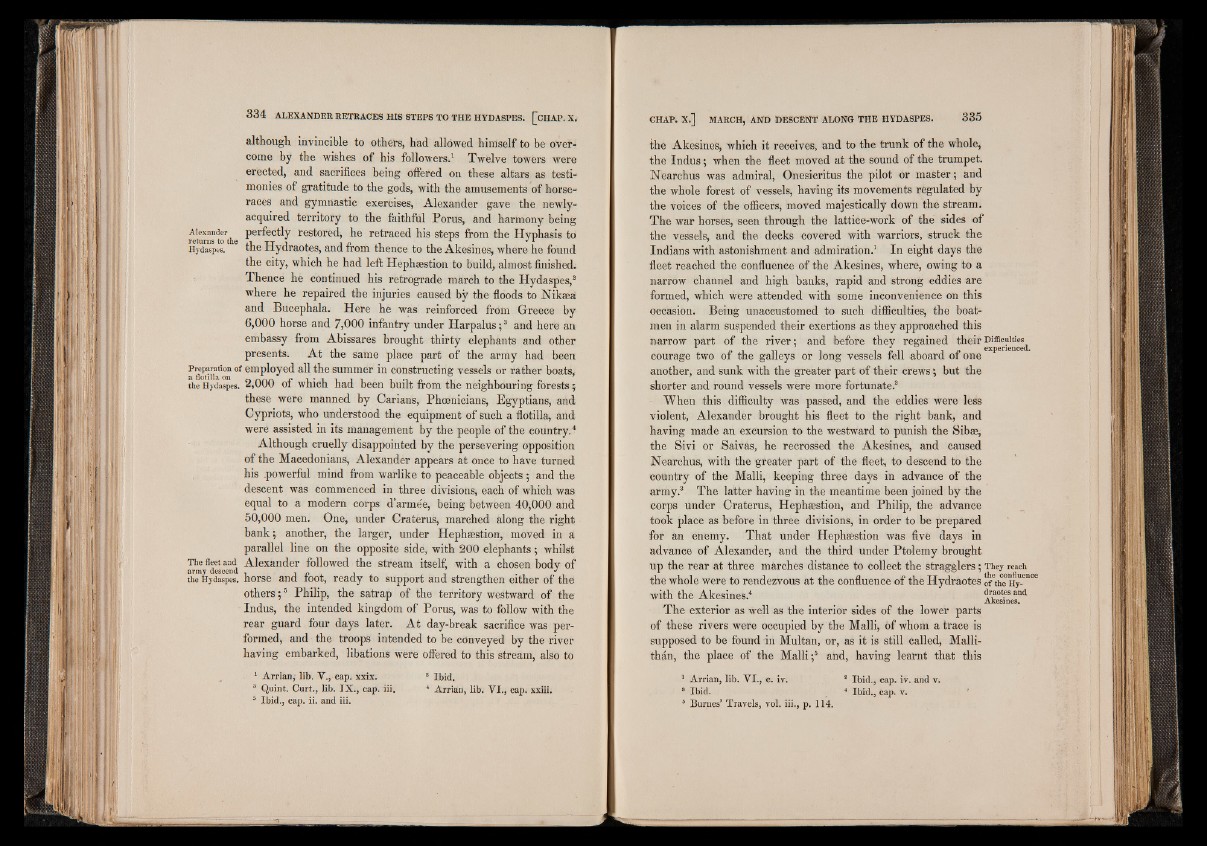
although invincible to others, had allowed himself to be overcome
by the wishes of his followers.1 Twelve towers were
erected, and sacrifices being offered on these altars as testimonies
of gratitude to the gods, with the amusements of horse-
races and gymnastic exercises, Alexander gave the newly-
acquired territory to the faithful Porus, and harmony being
lx-turnsto'the Peid>ec% restored> he retraced his steps from the Hyphasis to
Hydaspes. the Hydraotes, and from thence to the Akesines, where he found
the city, which he had left Hephæstion to build, almost finished.
Thence he continued his retrograde march to the Hydaspes,2
where he repaired the injuries caused by the floods to Aikæa
and Bucephala. Here he was reinforced from Greece by
6.000 horse and 7,000 infantry under Harpalus ;3 and here an
embassy from Abissares brought thirty elephants and other
presents. At the same place part of the army had been
PflePHiati°n °f emPloyed ad the summer in constructing vessels or rather boats,
the Hydaspes. 2,000 of which had been built from the neighbouring forests 5
these were manned by Carians, Phoenicians, Egyptians, and
Cypriots, who understood the equipment of such a flotilla, and
were assisted in its management by the people of the country.4
Although cruelly disappointed by the persevering opposition
of the Macedonians, Alexander appears at once to have turned
his .powerful mind from warlike to peaceable objects ; and the
descent was commenced in three divisions, each of which was
equal to a modern corps d’armée, being between 40,000 and
50.000 men. One, under Craterus, marched along the right
bank; another, the larger, under Hephæstion, moved in a
parallel line on the opposite side, with 200 elephants ; whilst
The fleet and Alexander followed the stream itself, with a chosen body of
army descend - t
the Hydaspes. horse and foot, ready to support and strengthen either of the
others ; 5 Philip, the satrap of the territory westward of the
Indus, the intended kingdom of Porus, was to follow with the
rear guard four days later. At day-break sacrifice was performed,
and the troops intended to be conveyed by the river
having embarked, libations were offered to this stream, also to
1 Arrian, lib. V., cap. xxix. 8 Ibid.
3 Quint. Curt., lib. IX ., cap. iii. * Arriafl, lib. Y I., cap. xxiii.
3 Ibid., cap. ii. and iii.
the Akesines, which it receives, and to the trunk of the whole,
the Indus; when the fleet moved at the sound of the trumpet.
Nearchus was admiral, Onesicritus the pilot or master; and
the whole forest of vessels, having its movements regulated by
the voices of the officers, moved majestically down the stream.
The war horses, seen through the lattice-work of the sides of
the vessels, and the decks covered with warriors, struck the
Indians with astonishment and admiration.1 In eight days the
fleet reached the confluence of the Akesines, where, owing to a
narrow channel and high banks, rapid and strong eddies are
formed, which were attended with some inconvenience on this
occasion. Being unaccustomed to such difficulties, the boatmen
in alarm suspended their exertions as they approached this
narrow part of the river; and before they regained their Difficulties
p v n p r i e n p n d courage two of the galleys or long vessels fell aboard of one
another, and sunk with the greater part of their crews; but the
shorter and round vessels were more fortunate.2
When this difficulty was passed, and the eddies were less
violent, Alexander brought his fleet to the right bank, and
having made an excursion to the westward to punish the Sibse,
the Sivi or Saivas, he recrossed the Akesines, and caused
Nearchus, with the greater part of the fleet, to descend to the
country of the Malli, keeping three days in advance of the
army.3 The latter having in the meantime been joined by the
corps under Craterus, Hephsestion, and Philip, the advance
took place as before in three divisions, in order to be prepared
for an enemy. That under Hephsestion was five days in
advance of Alexander, and the third under Ptolemy brought
up the rear at three marches distance to collect the stragglers; They reach
the whole were to rendezvous at the confluence of the Hydraotes 0/ the Hy^ence
with the Akesines4 Akesinesa<i
The exterior as well as the interior sides of the lower parts
of these rivers were occupied by the Malli, of whom a trace is
supposed to be found in Multan, or, as it is still called, Malli-
than, the place of the Malli;5 and, having learnt that this
1 Arrian, lib. V I., c. iv. 2 Ibid., cap. iv. and v.
8 Ibid. 1 Ibid., cap. v.
8 Burnes’ Travels, vol. iii., p. 114.